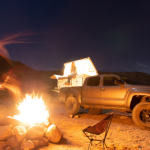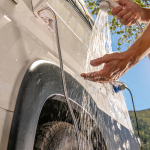Overlanding & Geocaching
Geocaching and overlanding are two outdoor activities that have become increasingly popular over the past few years. Both activities involve the use of GPS and navigation, and have become increasingly popular among outdoor enthusiasts.
Geocaching
Geocaching is an outdoor recreational activity in which participants use a GPS or other navigational techniques to hide and seek containers called “geocaches” at specific locations marked by coordinates all over the world. A typical geocache is a small waterproof container containing a logbook and “treasure,” usually toys or trinkets of little monetary value. A geocacher will place the geocache at a specific location and post the coordinates online. Other geocachers then use the posted coordinates to locate the geocache. When the geocache is found, the geocacher signs the logbook and may take an item from the geocache, if desired, and leave another item in its place.
Overlanding
Overlanding is a form of extended wilderness adventure travel that usually involves the use of a vehicle (such as a 4×4, SUV, or camper van) and a variety of activities such as sightseeing, camping, fishing, hunting, and exploring. Overlanding trips can last for days, weeks, or even months, and often involve extended stays in remote areas. Overlanders typically plan their own routes and use GPS, maps, and other navigational tools to find their way. Overland trips can include visits to national parks, scenic areas, or other points of interest, as well as off-the-beaten-path exploration.
Why Combine Them?
Both geocaching and overlanding require careful planning and navigation. Geocachers must use GPS to find their way to the coordinates of a geocache, and overlanders must plan their routes and use navigational tools to find their way to their intended destinations. Both activities also involve a certain level of risk, as geocachers and overlanders may find themselves in unfamiliar terrain. Therefore, it is important for both geocachers and overlanders to be prepared for any situation that may arise.
Overall, geocaching and overlanding are two exciting outdoor activities that offer a unique way to explore and discover the world. Both activities involve a certain level of risk so it is important to be prepared and to use navigational tools to ensure a safe and enjoyable experience. With careful planning, geocaching and overlanding can be an enjoyable and rewarding way to explore the outdoors.
Getting Started With Geocaching
To get started with geocaching, the first step is to sign up for an account on the official geocaching website. This will give you access to the geocaching community and allow you to search for geocaches near you. You can also use the website to discover geocaching events, get hints and tips, and read reviews of geocaches.
Once you have an account, you’ll need to decide what type of geocaching you want to do. There are several types of geocaches, including traditional, multi-cache, letterbox, and mystery caches. Traditional geocaches are the most common and involve finding a container with a logbook inside. Multi-caches involve finding multiple containers with clues that lead you to the final geocache. Letterbox caches involve finding a container with a stamp and logbook inside. Mystery caches involve solving puzzles or tasks to find the geocache.
The next step is to choose a geocache to find. You can use the official geocaching website or a geocaching app to search for geocaches near you. You can search by location, type, difficulty, and size. Once you’ve found a geocache, you can read the description, view the clues, and see the coordinates. It is important to note the coordinates and the description of the geocache before you head out.
When you’re ready to go geocaching, make sure you have all the necessary supplies. You’ll need a GPS device, a pen or pencil, a logbook, a flashlight, a bag or backpack, and a geocaching container, such as a Tupperware container or ammo can. You may also want to bring along a GPS which is a GPS receiver with a built-in radio.
When you arrive at the coordinates use your GPS device to navigate to the geocache. Once you’ve found the geocache sign the logbook with your geocaching username and date. You may also want to leave a note or an item in the geocache for other geocachers to find. When you’re finished be sure to put the geocache back exactly where you found it and leave the area as you found it.
Geocaching is a great way to get outside and explore the world. With a few simple steps, you can get started on your geocaching adventure. Have fun and happy hunting!



